How to Train a Dog for the Backcountry
Tips and Tricks for Introducing a Puppy to the Trail
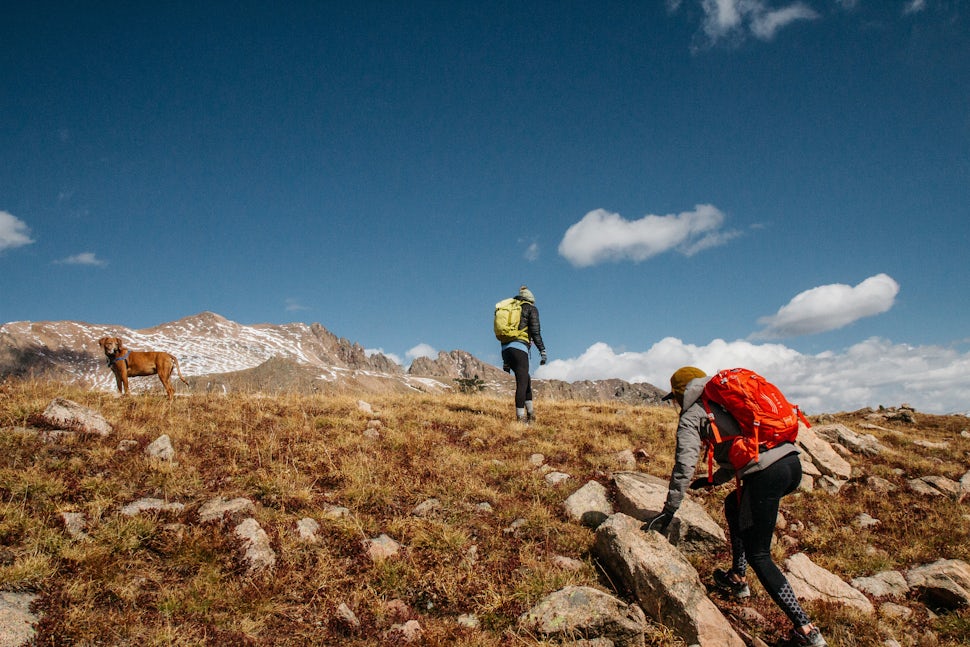
Understand whether or not your puppy enjoys going out with you.
My 8-year-old spotted terrier/chihuahua mix has been my built-in adventure pup for many years. Although she LOVES the outdoors and took very well to long days in the backcountry, I still had to spend countless seasons training her to enjoy the backcountry and be safe from any circumstance that comes our way.
I adopted an 8-week old chihuahua mix puppy named Taquito and nicknamed “little man.” He adores Moo and loves being outside, and although I wanted him to be my little adventure buddy, I was unsure if he would enjoy it.
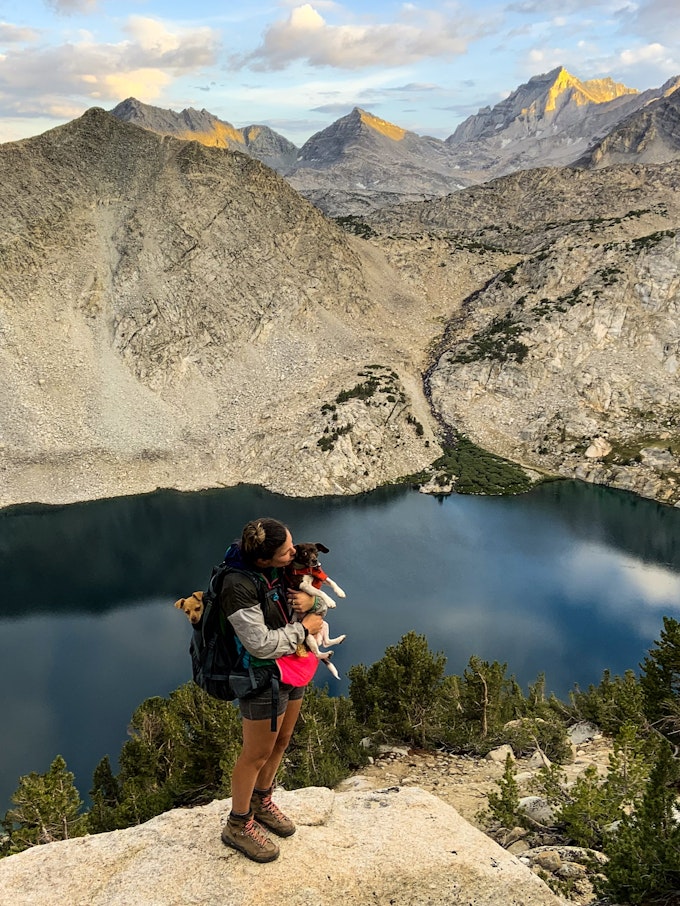
My 14-year-old Shih Tzu, who crossed the rainbow bridge earlier this year, did not. She preferred to stay home or lay outside in the sun or maybe a short walk here and there, but the backcountry was never her jam. I adapted to her wants and needs and gave her the best life. She was not a huge adventure dog, and I recognized and respected that. If your dog is not into camping or doing big miles on the trail, that is perfectly fine. You can still enjoy the outdoors, having micro adventures with your pup, such as short walks, going for picnics, road-tripping, or a day at the beach. My sweet Shih Tzu and I had lots of micro adventures that I will always cherish.
It just so happens my puppy, Taquito, LOVES the backcountry, which means I need to be hypervigilant about training him so he remains safe and we both are happy on our adventures.
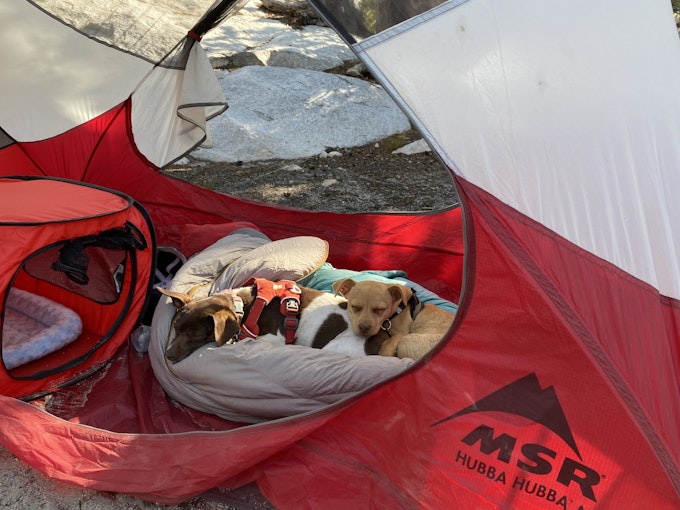
Have patience (and get those puppy shots).
When I first adopted Taquito, he only had one round of puppy shots, and therefore we had to wait 11 more weeks before he could walk on the trail. Since I wanted to get him outdoors but did not risk putting an unvaccinated puppy on the ground and potentially exposing him to parvo, I got him used to sit in my backpack while I went on short hikes. My hikes were no longer than 2 hours because this little puppy needed frequent potty breaks, so I had to get home in time to allow him to relieve himself since we were also potty training at this stage. I carried him in my arms and packed him in a backpack for neighborhood walks, hiking trails, and mini-lake days. He went everywhere with me because I wanted to get him adjusted to all the sights and smells. I wanted Moo to understand that he was now part of our pack.
Leash-train your pup.
I immediately bought Taquito a collar and leash and took him on walks around the yard, starting from day one. I wanted him to be comfortable and confident on a leash, and the earlier you start this, the easier it is. As he grew bigger, I transitioned to a harness, which he wears 24/7. Yes, he hated his collar and harness at first, and it took him a few days to adjust, but it slowly became a part of his everyday “uniform.” Once he finished all four rounds of puppy shots, I took him for as many leash walks around the neighborhood as possible before I introduced him to the trail. I wanted him to become comfortable and confident in multiple surroundings. I took him to stores, bars, the post office, the nursery, and every dog-friendly place in town so he could see, hear and smell all the things!
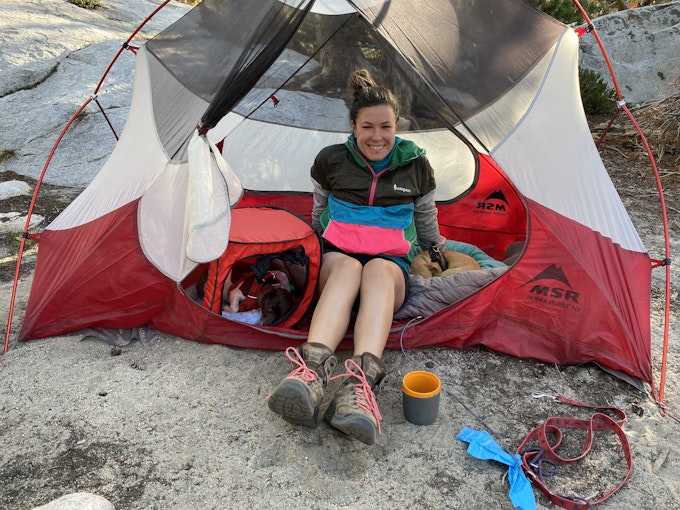
Introduce your puppy to the trail.
Once Taquito was vaccinated and leash trained, we immediately got into the backcountry. I chose Kearsarge Pass for our first “big trail day” in the backcountry. It is 9 miles roundtrip, with about 3,500 elevation gain and the pass itself is at 11,700 feet. I have done this pass before with Moo, and although I would not necessarily recommend this as a first trail hike for a dog, I was willing to take on the challenge because I knew I could put Taquito in my pack at any time and continue or turn around. I had zero expectations for this trail. I planned on leashing Taquito the entire hike, but after a mile on trail, I decided to unleash him since there were no other people around and mule trains are not common on this trail. To my surprise, he was fantastic off-leash. He stayed on trail, followed Moo, and constantly made eye contact with me.
Offer positive reinforcement.
I quickly learned he was terrified of other hikers on trail, which has been a work in progress. Each hiker who saw us on the trail was very patient and kind towards Taquito and waited for Taquito to gain confidence to sprint to me, past the “stranger danger” hikers. The more exposure a puppy has to his fears in a calm and positive setting, the more likely the puppy will overcome these fears. He learned to sprint past each hiker as fast as he could towards me, and that was that. I gave him a “good boy” praise and a treat each time he encountered another “stranger” and ran to me. Little man made it up to Kearsarge Pass by himself. I was shocked and so proud. The wind started to pick up, and Taquito quickly became terrified of being on a windy, somewhat exposed pass and had a complete meltdown on the top of the pass.
“Okay he is scared of the wind and people”, I thought to myself as I jogged down the pass. We can work on this!
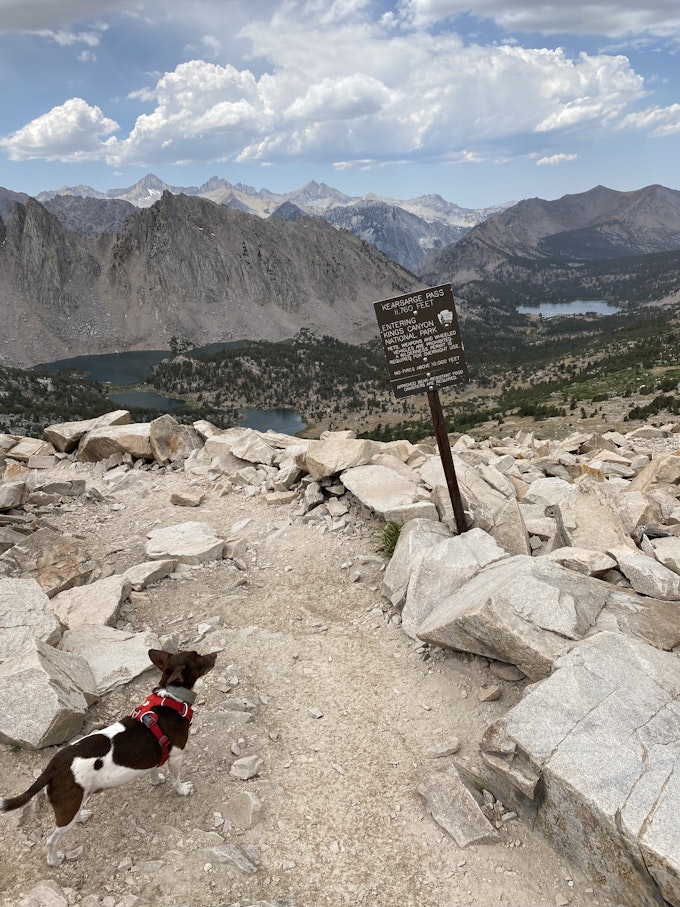
Go prepared: Paws, pads, hydration, nutrition, and recall.
Unfortunately, I have seen many dogs in the backcountry needing to be rescued because of dehydration and bloody pads. Your responsibility as a human is to prevent all of these things, even if that means stopping, slowing down, and attending to your dog. I have gotten off trail, taken extra zero-days, carried my dog for miles because I saw warning signs in Moo that made me uncomfortable. There is nothing wrong with stopping, slowing down, or turning around if that means making it a better experience for your pup. I make it a point to tell every individual who goes into the backcountry with Moo and me that our plans can change, based solely on how Moo is doing.
Paws and pads: I am a true advocate of Musher’s Secret Dog Paw Wax. I apply it to all pads on every dog I take on trail before we start our hike. I will reapply every 5 miles and check pads for redness, cracks, soreness, or anything stuck in between pads every three-ish miles. Protecting your dog’s pads is crucial. I have used dog booties in the past, but the only ones I found that work are PAWZ, and Moo still tries to bite them off. As a result, I do not use them regularly, but I still carry them in my first-aid kit just in case. I also have Musher’s wax in my first-aid kit. Before heading out on the trail, make sure your dog’s nails are trimmed short.
Hydration: I carry a doggy water bottle that is easily accessible at all times and always have 1 liter of water in my pack as a backup. I stop every mile to give water to my dogs, and on hot days, I am stopping much more frequently. I also pour water on their coats to cool them down and carry cooling vests in my pack for hot days on trail. Soaking the cooling vest with cold water helps the dog stay cool for longer. I have the Ruffwear version, and it is a must-have when hiking in warm weather.
Nutrition and recall: I carry an endless supply of dog treats in my pack as dogs burn calories and need fuel just like we do. I also carry a tiny plastic sealed pack of wet dog food in my emergency kit, and if I know I am going to be on trail all day, I plan on giving my dogs a full meal halfway through. I prefer Cesar wet food in 3.5 oz plastic packs. On overnight or multi-day trips, to save pack weight, I bring dehydrated ground beef and rice which I cook and dehydrate at home and add boiling water on trail.
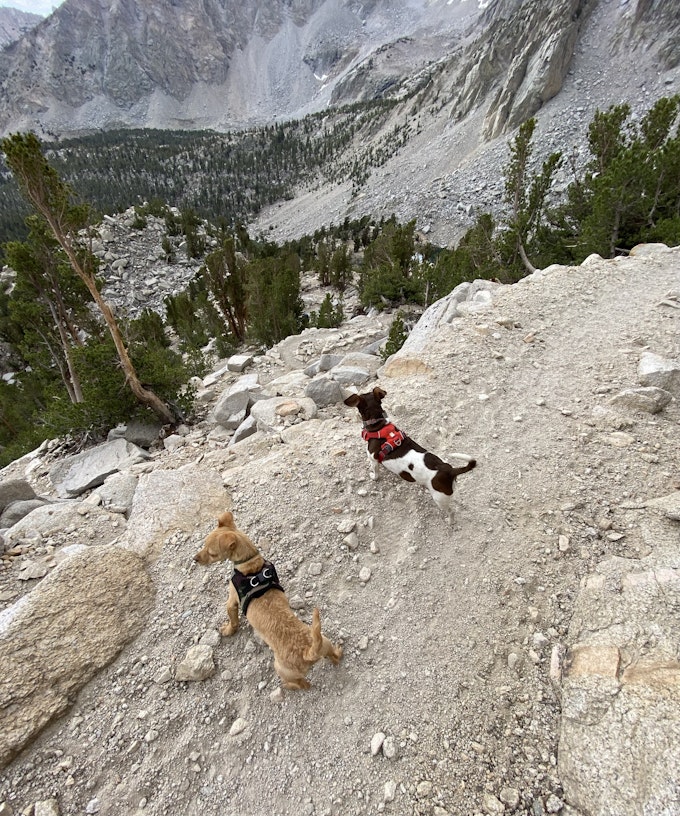
Recall on trail is challenging, mainly because there are SO many smells and distractions. However, you need to always be in control of your dog and recall back when necessary. Wild animals, mule trains, aggressive dogs, people are always out there, and we need our dogs to come back to us when we call them. This is still a work in progress for puppy Taquito, but I use treats as much as possible to recall him back to me. I carry a squeaky toy bone on the trail as Moo learned recall from squeaky toys. Whenever I want to recall Moo, I squeak the bone, and she comes back. Every dog is different, so you have to experiment on what works and what does not work. If you are not confident in recall, then I would recommend keeping your dog on leash. I always leash my dogs in the morning and evening on the trail and at camp, as I call these times “coyote hour.” Although my dogs are off-leash most of the trail, I always carry a leash in my hand, and I am always ready to leash a dog when I need to.
Prepare for camping.
Taquito went on his first overnight backpacking trip after a couple of weeks of trail training. Since he is a puppy and is still crate trained, I purchased a lightweight pop-up crate to put in my tent to normalize his sleep environment as much as possible. I also brought a tiny dog bed so he can be nice and cozy. Tents can be very scary to dogs, and I did not know what to expect. I always suggest setting up your tent at home and introducing it to the dog in your living room. When we first got to camp, I set up the tent, opened both doors, sat inside, and sprinkled treats everywhere. Taquito was hesitant at first, but after a few steps in the tent, he relaxed and went straight for the treats. I sat in the tent with him for about 20 minutes and realized he was not scared of the tent. I set up his bed and toy inside his pop-up crate, and he was happy as a clam. I recommend bringing a chew stick if your puppy is still in the chewing phase. At night, I put him in his crate inside my tent and draped my clothes over the mesh for warmth and to give him my scent. He slept through the night without any problems. I tie Moo and Taquito up at camp during dusk and dawn since these times are peak coyote hours, and I do not want them running around off-leash. He barely ate dinner that night. However, Moo was a hesitant eater when she first started backpacking with me. I am a big fan of “they will eat when they are hungry,” and he chowed down the following day at breakfast!
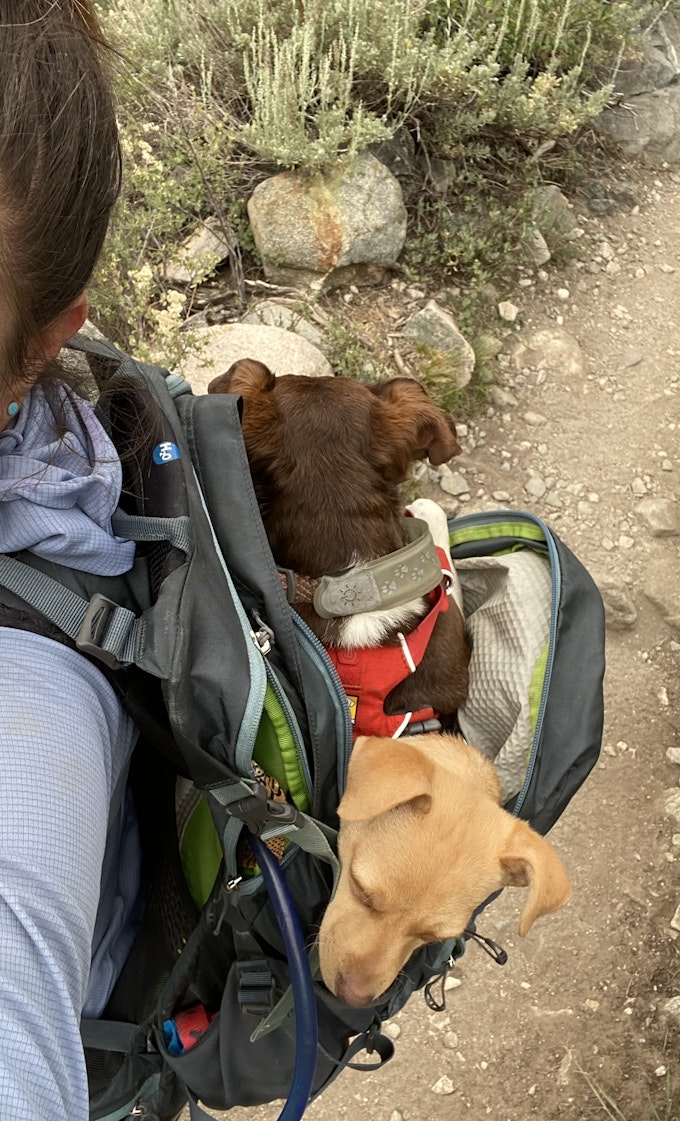
Know your environmental threats and how to treat them.
Thunder: Moo has been through plenty of thunderstorms on trail to the point that she trots along beside me as I run to safety. I will pack her in my foldable daypack if the hail and thunder become incessant. Taquito has yet to experience a thunderstorm on trail, but I think I will carry him at first, so he feels safe, while getting used to the noise and rain.
Wildlife: This is where recall comes in as whenever I see any wildlife on trail, I immediately recall the dogs back. If I run into a bobcat, mountain lion, or coyote, I immediately leash and pick up my dogs as quickly as possible. Even if that means ditching my pack for the time being. Unfortunately, little dogs on trail are prey, and it is essential to be aware of predators and know how to protect yourself and your pups.
Injury: Dogs can and will get injured on the trail, so it is important to carry essential items in your first-aid kit and a sling or foldable backpack to carry them when necessary. I take a foldable REI backpack that I wear on my front in case I have to carry a dog or two.
Doggy first-aid kit: I carry a few key items in my first-aid kit for my dogs. They include the following:
- Benadryl
- Doggy pain pills (prescribed by my veterinarian)
- Tweezers
- Scissors
- Dog booties
- Peanut butter
- Alcohol prep pads
- Neosporin
- Musher’s secret wax
Mule trains: They are common in the Eastern Sierra, and they are pretty impressive. I first started getting my dogs used to mule trains by stopping on trail, pulling off to the side, and picking the dogs up in my arms. Taquito lost his little mind when he saw his first mule train, and I sat there giving him positive reinforcement. The second mule train he saw, he was much better, and by the third time. He was on the ground, leashed and sitting off-trail. The mule handler commented on how well-behaved my dogs were. Moo knows to immediately get off the trail and sit down next to me when she sees a mule train, and I am confident Taquito will get there soon! I don’t want my dogs to bark or growl in front of mules because it can spook them, and deadly chaos can break out. It is so important to respect mule trains and their handlers.
Mileage: Start slow and go slow is my motto. Puppies’ joints don't fully form until they are at least one year old, so it is super essential to limit mileage, even if they want to go further. This is especially true for bigger dogs who are more prone to joint dislocations and stunted growth. I spoke with my veterinarian about my plans with Taquito, and he gave me the “go-ahead” for five miles at a time, which is what we do. If I do more miles which is often, I pack him in my backpack and continue. I would consult with your vet about your puppies’ growth and bone structure before you head out on the trail.
Cover photo: Holly Mandarich
We want to acknowledge and thank the past, present, and future generations of all Native Nations and Indigenous Peoples whose ancestral lands we travel, explore, and play on. Always practice Leave No Trace ethics on your adventures and follow local regulations. Please explore responsibly!
Do you love the outdoors?
Yep, us too. That's why we send you the best local adventures, stories, and expert advice, right to your inbox.








